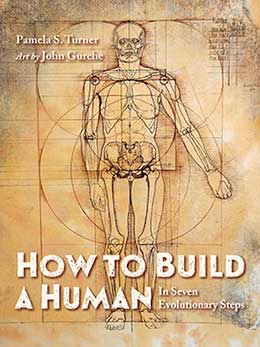
Pamela has written a wide variety of nonfiction and fiction, including Crow Smarts, Samurai Rising, The Dolphins of Shark Bay, The Frog Scientist and Hachiko.
We’re talking with her about her most recent book, How to Build a Human: In Seven Evolutionary Steps (Charlesbridge 2022; art by John Gurche).
As a starred review in The Horn Book says, “‘Evolution is a journey, not a destination.’ The paths and branches of human evolution, from our primate ancestors to Homo sapiens, are thoroughly covered…Turner is a consummate storyteller: her steady pace through millions of years of the human evolutionary line is buoyed by an amused stance, joke-filled footnotes, well-timed shifts into second person, and modern-day analogies attuned to a middle-grade audience. At the same time, she is meticulous in emphasizing the main underlying concepts of evolutionary science: her terms are precise, her representations of scientific knowledge clearly differentiate between hypothesis and established fact, and she confronts misconceptions head on (see especially a powerful statement about the unscientific construct of race: ‘race is a cultural construct, not a biological reality’).”
Pam, did your goal in writing this book change from the research-gathering phase to the submitting-it-to-your-editor stage?
Surprisingly, not that much. I had several goals from the onset. The first was to make human evolution understandable. I have always been interested in the topic but found it very confusing because of all the different species names, and the way fossils get re-categorized and re-named as the science progresses. So I decided to frame the book around major steps in human evolution, both physical and cognitive, and picked seven. All of the steps were obvious choices, except perhaps my decision to separate language and storytelling. Throughout the text I intentionally used as few species names as possible, and I intentionally omitted the history of who found which fossil when. While interesting, I felt it distracted from the story arc.
How did you organize your research?
 Once I had my basic outline — the seven steps — I started reading the work of experts in the field. When I had some piece of information I wanted to include, I would make a summary and note the reference. Basically I would drop the tidbit into one of my seven buckets. I sought out and cited original scientific articles whenever possible, rather than relying on what somebody wrote in The New York Times or wherever. I sought out books by experts in their field. If that expert cited something within their area of expertise (chimp behavior, for example) I accepted it as solid, but if they wrote something about an area outside their expertise (fossil dating techniques, for example) I would check their reference and/or seek out a more authoritative reference. In a few cases with conflicting data I asked the opinion of the paleoanthropologists who were my expert reviewers.
Once I had my basic outline — the seven steps — I started reading the work of experts in the field. When I had some piece of information I wanted to include, I would make a summary and note the reference. Basically I would drop the tidbit into one of my seven buckets. I sought out and cited original scientific articles whenever possible, rather than relying on what somebody wrote in The New York Times or wherever. I sought out books by experts in their field. If that expert cited something within their area of expertise (chimp behavior, for example) I accepted it as solid, but if they wrote something about an area outside their expertise (fossil dating techniques, for example) I would check their reference and/or seek out a more authoritative reference. In a few cases with conflicting data I asked the opinion of the paleoanthropologists who were my expert reviewers.
What about the writing process?
After my research — I think I used about 150 sources in the bibliography — I had 100 pages of single-spaced notes organized into my seven steps. The actual writing was a blast because it was a total riff. I had the background in my head, I knew I had to weave in certain themes that would pop up again, but otherwise I felt very free creatively. Which is why Human has silly footnotes and quirky digressions, like the one about the Japanese writing system.
What was the hardest part to write?
Hands down, the hardest was “A Note on Race.” I didn’t feel that discussion belonged in the main text because I ended my saga at around 40,000 years ago when no such concept existed, and in any case, 40,000 years ago all humans were what we would now call people of color. But it was really difficult to compose “A Note on Race” because it needed to be concise (nobody’s going to read a 20-page author’s note) while making a nuanced argument: that race and racism are real, and have real biological impacts, even though race isn’t biological. Yikes. I was lucky to have Habiba Chirchir’s help. She’s the Kenyan paleoanthropologist who wrote the foreword and she offered very insightful comments on my first draft. (Which was probably my fifteenth draft…it took a long time to get it right.)
Do you think the subject (human evolution) is going to be controversial?
I won’t be surprised if Human gets banned somewhere. When Human was discussed on School Library Journal’s Heavy Medal blog, someone left a comment stating they didn’t like Human, arguing that it was “biased” and “one-sided” because it didn’t include a creationist account. I’m afraid there are quite a few people with this view. (Such folks would never, of course, contemplate the reverse: Sunday school teachers being obliged to discuss evolution through natural selection!) So I think that despite the need for middle schoolers to understand and engage with this topic, How to Build a Human will be officially banned here and there, and “soft banned” more widely. By this I mean that some librarians and teachers will not purchase it, either because they object to the book or they anticipate community challenges. Or it might be purchased but then quietly removed from the shelves. Or “lost” and not replaced.
What impact do you hope Human will have on readers?
In recent years there’s been a laudable emphasis on human diversity. We should also celebrate human universals. I think How to Build a Human connects us to what we all have in common as Homo sapiens. And besides improving scientific literacy, belief in evolution has been linked to less prejudice towards “out-groups” and a reduction in racism. I can’t think of a better reason to understand human evolution than that!
Resources
As she always does with each book she publishes, Pamela S. Turner features fabulous resources on her website. Be sure to click on “More on Human Evolution” in the sidebar of her How to Build a Human website page for a full page of resources.

This is a gem of a book! It’s on my “best of” shelf and deserves to be in every library. A truly remarkable combination of deep, careful research, great writing and a marvelous wit.
Thank you for your excellent book that explained evolution in a way that was both fascinating and easy (easier) to understand. I loved all the resources you provided, and during and after reading your book, I spent lots of time on the Smithsonian website. I also enjoyed the links you provided in this interview. I really appreciate all the research, time, and effort put into your wonderful book.